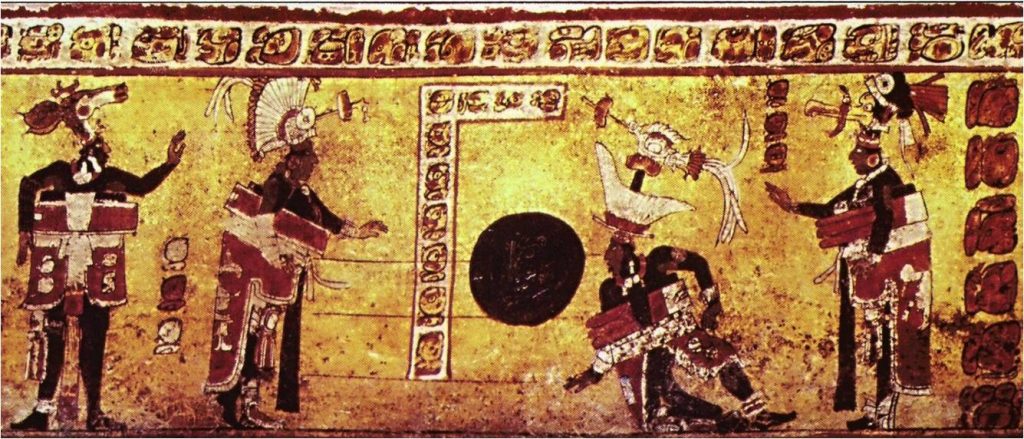El juego de pelota, dating back to 1500 BCE, is known as the oldest ball game ever created in human history. It was played across many Mesoamerican civilizations and recognized as one of the most solemn events of that time. The game held religious, social, political, and ritualistic significance unlike any other. This sport was more than just a game, but quite frankly, it was an event that often resulted in life or death.
The origins of this game are not precisely known, but many historians believe its first appearance to have derived from the Olmec society, the first major civilization in Mesoamerica.1 The Olmecs, who inhabited the gulf coast of Veracruz, were recognized for their development of latex in the pre-classical era. In fact, many game balls consisting of latex have been recovered from the region and have led historians to believe this evidence to be the origins of this great, ancient game. As millennia have gone by, several different Mesoamerican civilizations have adopted this sport and created their own unique styles of play. However, the general idea of the game was never changed.
The ball game consisted of two teams, ranging between two to four players. The players would wear protective garments and sometimes dress up in representations of an animal. Depending on the situation and culture, players would compete on uniquely structured ball courts. On game-day all members of the society would gather around with excitement for the big match up. Unfortunately, this was no light matter, and nothing close to our typical spectator-sports.2
There has been approximately thirteen-hundred courts discovered, from the state of Arizona to the southern most parts of Paraguay. These courts were comprised of a large, flat field with two walls on each side. Typically, these walls would be slanted. However, with many different cultures, these ball courts were not all the same across the geographic regions. However, they all had one thing in common: a ring mounted on the wall (whether it was flat or slanted). This large stone ring (on both sides), standing high and tall on the wall, would be the area where the players would aim to score. The goal of the team was to hit the rubber ball, without using their hands, into the mounted ring. In order to hit the ball, they would propel their bodies and fling their hips. This difficult motion made the game a challenge, and it was only capable of being played by a select few of each society.3

Unlike any other game, it was made up of tactical movements rarely seen in today’s professional sports. Players risked severe injuries by throwing there bodies across the stone court. In addition, the impact of the rubber ball could cause horrible bruising, often leading to internal bleeding, and possibly even death. If the game did not kill the player, the outcome certainly could. Due to the game’s religious nature, players who lost the match would often be sacrificed to the gods and killed in a ceremonial event.4
This game was a big influence across societies in Mesoamerica. It was not only a sport, but a highly regarded event. The Mayans considered it an opening to the underworld and intertwined the sport with mythological significance. The cost of losing would conclude in a sacrificial act; in this way, members of the society were able to keep their gods happy and ultimately balanced. As time went by, when the Aztecs adopted the game, it was seen as a problem solver. Players would compete on the stone courts, fighting for hierarchy and dominance. This formal competition would also lead to solving political conflicts. It was a great act of gamble, and certainly one with great significance.5
No matter the society, this game left a most distinctive resonance. It endured through many civilizations as the centuries went by, and created a sport with rich meaning. Whether through the symbolism of mythological gods or simply for the sake of competition, this ball game left details and stories of the once great civilizations of Mesoamerica. Although today’s evidence is limited, the message given across these magnificent stone courts is clearly shown.
- Jeffrey P. Blomster, “Early Evidence of the Ballgame in Oaxaca, Mexico,” Proceedings of the National Academy of Sciences of the United States of America 109, no. 21 (2012): 8020–25. ↵
- Salem Press Encyclopedia, January 2015, s.v. “Mesoamerican Ball Game,” by David A. Crain. ↵
- Colleen P. Popson, “Extreme Sport,” Archaeology 56, no. 4 (October 9, 2003): 42–48. ↵
- Zaccagnini Jessica, “Maya Ritual and Myth: Human Sacrifice in the Context of the Ballgame and the Relationship to the Popol Vuh” (Honors Thesis, Southern Illinois University Carbondale, 2003), 2-11. ↵
- World History Encyclopedia, 2011, s.v. “Mesoamerican Ball Courts – Fusing Game and Religion,” by Alfred J. Andrea and Carolyn Neel. ↵



70 comments
Nicolas McKay
What an amazing read. I have often made the joke watching sports on tv that the athletes play like their lives depend on it, but the for Mesoamericans their lives actually did depend on it. Its very interesting reading about such a brutal and intense religions practice. I do wonder if this sport could have had any influences on the modern sports we play today
Anayeli Prieto
Great article! El juego de la pelota is a game that i had never before heard about. its interesting to learn about all of the different ways they came up to keep themselves entertained. i feel that the rim on the wall can be compared to the sport of Basketball. Another sport that i can relate this to is soccer because the players were not allowed to use their hands. Sports like these can be the beginning for the sports that we see today and its very interesting to know how they begin.
Zaraly Frasquillo
Talk about not knowing how to take a loss. I am from Arizona but I did not know that there were playing fields were discovered there, so that is great information to know. This article was super interesting although I would have loved a bit more information on what was considered as Mesoamerica (I should probably know but I do not).
Gabriela Medrano
The last time I read on this was my sophomore year in high school, so I’m glad to see that it is still a topic to pitch out an entire article on. This article served as a refresher, some information was already known knowledge however, I did not know the Mayans kept it as a symbol to mythological gods. The beginning of the article was a bit dull and I lost interest because I expected something more gruesome or significant given from my past reads on the subject. However, you finished off strong and well put the sequence of its content.
Sergio Cervantes
I have only heard about these types of games once, but never realized the consequence of a loss being death. It truly changes the whole perspective of this sport and the civilizations of that time. It provides an in-depth look as to how the people of these areas viewed human life and how they revered their gods. Another thought comes to mind, this being the great skill and athletic ability the competitors had whilst playing the games. The picture allows one to view the height at which the rings were set and the texture of the field that was used. It seems painful, exhausting, and gruesome. A great read!
Yesenia Cardenas
I knew that this game was of Mayan origin but I did not know that the Aztecs adopted the game to solve conflicts. I wonder how many people decided to lose their argument rather than risk losing their lives.
Maalik Stansbury
I like it when I hear about diverse culture. It reminds me of the different places i grew up in the world and how people were expressed and expressed themselves in a different manner than i did myself, as well as my family. I think you did a great job explaining the topic and describing the cultural background of it all. But the game itself was crazy, who in the right mind would do that. Death is not an option im down with
Aaron Jaramillo
Good article. I also did an article on this subject but was unaware that they had discovered thirteen hundred courts with one as close as the state of Arizona. I was amazed how a ball game was used from a paying homage to gods to simply entertainment and that the players would most often lose their lives for losing.
Christian Lozano
I remember seeing this game in the kids cartoon movie El Dorado. I usually feel bad for the losers of any game or sport, but the losers of this game get my deepest sympathy. Great article, good job and keep it up.
Maranda Avina
Very interesting article and informational. Its interesting to hear about the practices and rituals followed by different cultures, they are so different from many that we practice here. There is so much history that we do not know about and getting to read articles like this makes you appreciate the past and the ways it has shaped our future. Great job!